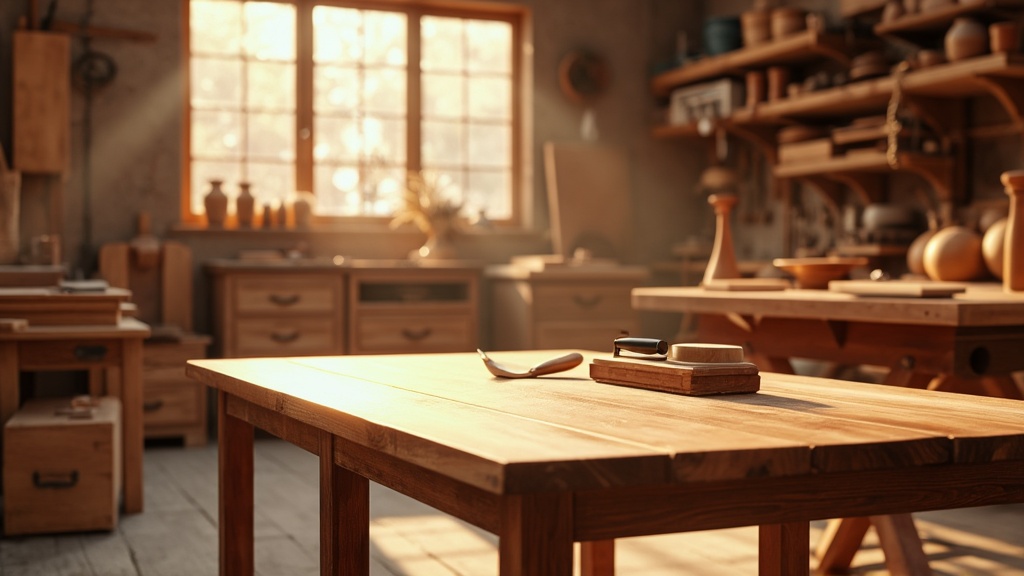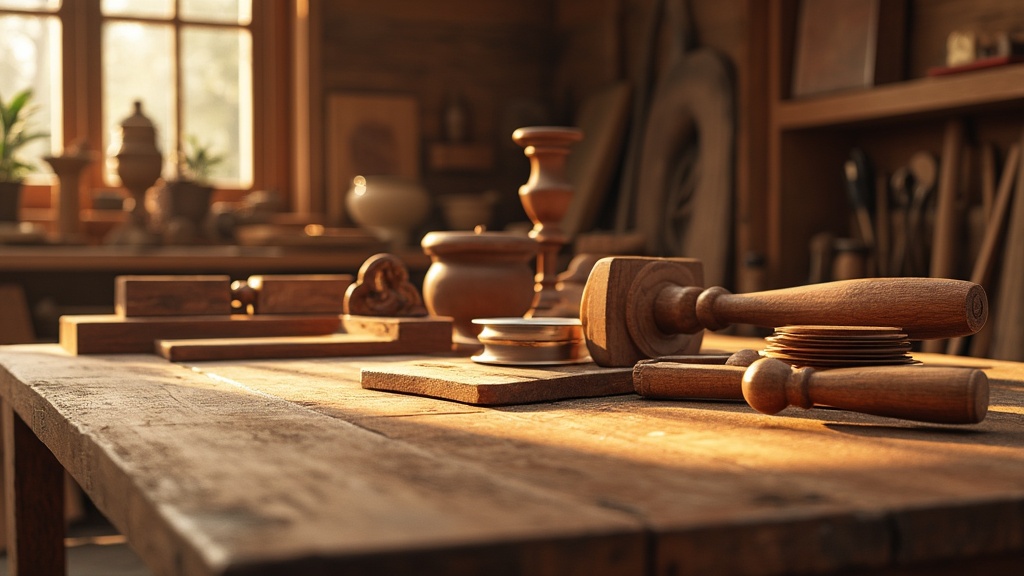Achieving lasting beauty in wood surfaces requires skillful wood polishing techniques. These techniques not only enhance aesthetics but also serve as essential furniture care practices.
Historically, wood polishing has roots in ancient civilizations, demonstrating its timeless importance.
Proper techniques heighten the longevity of finishes, with different wood types necessitating tailored approaches for optimal results.
Wood finishing enhances overall appearance, ensuring surfaces maintain their charm over time. Understanding essential tools like polishing compounds and the effects of various natural finishes can yield stunning outcomes.
Exploration of traditional methods, such as wax application using beeswax, empowers DIY enthusiasts and professionals alike to create beautiful, durable pieces.
Click here to learn more about: how to polish wood
Surface Preparation Techniques
Effective surface preparation plays a vital role in achieving a flawless wooden finish. Proper surface treatment ensures that finishes adhere evenly, thereby reducing the risk of chipping or peeling.
Wood finishing results rely heavily on selecting the appropriate grit sandpaper, which significantly influences the project’s success.
For example, coarse grit (60-80) is ideal for removing old finishes, while medium grit (120-150) smooths surfaces after the initial pass.
Utilizing fine grit (220 and above) is essential for perfecting the surface before the application of any finish. Scanning various wood types necessitates testing in small areas to achieve the desired effect.
Choosing the Right Grit Sandpaper
The selection of the right grit sandpaper effectively influences the outcome of the polish.
Coarse grits are ideal for aggressive material removal, while fine grits provide the smooth finish necessary for final touches. Surface preparation techniques are often defined by the smoothing process that precedes finish application.
A practical tip is always to perform a compatibility check on the sandpaper with the specific wood types being used, ensuring optimal results.
Investing time in surface preparation significantly enhances the durability of wood finishes.

What Are The Best Polishing Compounds
Selecting the most suitable polishing compounds plays a significant role in achieving a flawless surface finish on wood. Various types of polishing compounds, including waxes, oils, and abrasive pastes, can dramatically affect the end result of your woodworking projects.
Each compound has unique properties that enhance the wood’s inherent color and grain, thereby showcasing its natural beauty.
Performing tests on sample surfaces prior to full application is advisable, as this allows you to evaluate how different compounds interact with specific wood types.
Tip: Utilizing a small section on your workpiece provides a valuable opportunity for assessing texture and shine effectively.
The Role Of Hand Tools In Wood Finishing
The use of hand tools provides exceptional precision in wood finishing. Tools such as chisels and scrapers enable craftsmen to achieve remarkably smooth surfaces with unparalleled control.
Hand tools, in contrast to power tools, offer finer adjustments that ensure enhanced detail and meticulous craftsmanship. Regular maintenance of hand tools ensures a longer lifespan; it is advisable to sharpen blades consistently and store tools in a moisture-free environment to avoid rust.
This straightforward maintenance routine guarantees that your hand tools remain efficient for many years, solidifying their role as essential instruments for high-quality woodworking projects.
- Different polishing compounds can enhance the wood’s natural color and grain, improving the overall aesthetic of the project.
- Hand tools provide greater precision and control compared to power tools, allowing for more detailed and meticulous woodworking.
- Regular maintenance of hand tools, such as sharpening and proper storage, can significantly extend their lifespan and effectiveness.
- Testing polishing compounds on sample surfaces can help determine the best option for specific wood types, ensuring optimal results in finishing.
How Do Power Tools Enhance Polishing
Power tools enhance polishing effectiveness by transforming the efficiency and uniformity of the results obtained. Utilizing power tools enables completion of polishing tasks in a significantly shorter time compared to traditional manual methods.
This increased efficiency facilitates quicker project completion, allowing for additional focus on varied tasks.
Power tools ensure more consistent outcomes, which manual polishing methods may struggle to achieve, ultimately providing a higher-quality finish on wood surfaces.
Reduced physical strain accompanies the use of these tools, making them suitable for users across various skill levels. To ensure safety, remember to wear appropriate personal protective equipment (PPE) such as goggles and masks during operation.
Advantages of Power Tools Over Manual Techniques
Many people may not realize that power tools offer several distinct advantages over manual polishing techniques.
These benefits include:.
- Time Efficiency: Power tools allow for quicker application of polishing compounds, cutting down the overall project duration.
- Consistent Results: The rapid rotation and consistent pressure from power tools provide a uniform finish that hand tools may not replicate.
- Ease of Use: Many power tools are designed ergonomically, reducing user fatigue during extended polishing sessions.
To maximize these advantages, safety practices should remain a priority. Always read the manufacturer’s instructions and perform a compatibility check with the polishing compounds being used.
Effective Sanding Methods For Smooth Surfaces
Achieving smooth surfaces is largely dependent on the effectiveness of sanding techniques employed throughout the finishing process. Implementing correct sanding methods directly influences the visual quality and longevity of wood finishing projects. The sequence of sanding grits plays a crucial role; it is advisable to follow these steps for optimal results:
Start with 80 grit: This grit is ideal for initial shaping and smoothing the roughest areas.
Progress to 120 grit: This grit helps level the surface and prepare it for finer detail.
Finish with 220 grit: This provides the smoothest finish, enhancing the aesthetic appearance of the wood.
This methodical approach to sanding helps eliminate scratches which might affect the final wood treatment. It’s essential to recognize that effective sanding is foundational to ensuring quality assurance in wood finishing practices.
Power Tools and Sanding
- Power tools can reduce polishing time by up to 50% compared to manual methods.
- Consistent pressure from power tools can result in a finish that is 30% smoother than hand polishing.
- Using ergonomic power tools can decrease user fatigue by approximately 40% during prolonged use.
- Following a proper sanding grit sequence can eliminate up to 90% of visible scratches on wood surfaces.
Exploring Wax Application For Furniture Care
Wax application significantly contributes to effective furniture care by providing a dual benefit of aesthetics and protection. Serving as a crucial finishing touch, it complements the polishing completed earlier.
By enhancing the visual depth of wood finishes, wax beautifies surfaces while increasing their durability against daily wear.
A lesser-known fact is that natural beeswax acts as a mild abrasive, rendering it particularly effective in maintaining polished surfaces.
Choosing the appropriate wax for your furniture requires consideration of different wood types.
Softwoods benefit from softer wax, allowing for easier application, whereas hardwoods necessitate a harder wax for improved protection. Various wax types influence sheen and durability, with options like carnauba wax providing a higher gloss finish compared to alternatives.
Tips For Using Buffing Pads Effectively
Achieving a professional-grade luster on furniture relies heavily on the effective use of buffing pads.
Selecting the right buffing pad is essential, as it should align with the type of polishing compounds used; different materials impact the final finish significantly. For optimal results, applying even pressure and employing circular motions is key to preventing scratches and attaining a uniform shine.
Technique is paramount for achieving desired luster while using buffing pads.
Maintaining the longevity of your buffing pads is crucial; cleaning them after use ensures consistent performance.
Consider the following tips for proper care:.
- Use a mild detergent to effectively wash away compound residues.
- Store the pads flat to prevent deformation and preserve structural integrity.
Regular maintenance ensures that your buffing pads remain in optimal condition, leading to superior surface treatment over time.
Wax Application and Buffing Pads
- Waxing not only enhances the appearance of furniture but also increases its resistance to scratches and moisture.
- Using the correct type of wax according to wood type can prolong the life of furniture finishes significantly.
- Buffing pads made from different materials can produce varying degrees of shine, impacting the overall aesthetic of the furniture.
- Regular maintenance of buffing pads can improve their effectiveness and ensure a consistent finish on surfaces.
How To Achieve A Highgloss Finish
Creating a highgloss finish involves a series of precise steps that culminate in a visually striking result. Surface preparation is paramount; it ensures that the wood is smooth and free from imperfections.
Begin with sanding the surface using progressively finer grits:.
- Start with 120-grit
- Transition to 220-grit
- Finish with 400-grit to achieve a polished surface
This approach significantly enhances the overall gloss level. Tip: Always maintain a clean workspace to prevent dust particles from settling on the finish.
Selecting the Right Protective Layer
The choice of a protective layer is essential for achieving a highgloss finish. A clear polyurethane or lacquer specifically formulated for high gloss is ideal. When applying, opt for:
- A foam brush for a smooth application
- A spray applicator for an even coat
Tip: Apply thin, even coats and wait 2-4 hours of drying time between applications for optimal results.
The final step involves buffing the surface with a polishing compound once the last coat has dried. This step is crucial for achieving that desired shine enhancement. Tip: Utilize a microfiber cloth to ensure a streak-free finish. Following these techniques diligently will result in a remarkable highgloss finish that enhances the beauty and durability of your woodworking projects.
Achieving a Highgloss Finish
- Proper surface preparation can increase the adhesion of the finish, resulting in a more durable coating.
- Using finer grits of sandpaper reduces the visibility of imperfections, enhancing the overall gloss level.
- Applying multiple thin coats of finish allows for better leveling and reduces the risk of runs or drips.
- Buffing with a microfiber cloth helps to eliminate any remaining imperfections and enhances the shine of the finish.


